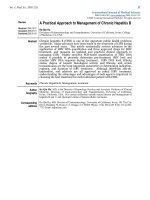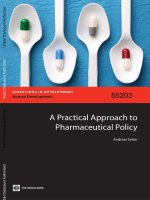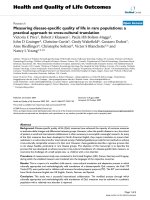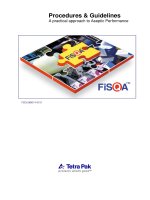Ebook A practical approach to obstetric anesthesia (2/E): Part 2
Bạn đang xem bản rút gọn của tài liệu. Xem và tải ngay bản đầy đủ của tài liệu tại đây (18.34 MB, 707 trang )
PostpartumIssues
PostcesareanAnalgesia
RichardN.Wissler
I. Introduction
II. Multimodaltherapy
A. Goals
B. Componentsofmultimodaltherapy
III. Medications:oral,systemic,neuraxial,andregionaladministration
A. Opioids
B. Localanesthetics
C. Nonsteroidalanti-inflammatorydrugs
D. Acetaminophen
E. Othermedications
F. Medicationsinbreastmilk
IV. Summary
KEYPOINTS
1. Theuseofmultimodalanalgesiaanddifferingroutesofadministration
willincreaseoverallpostcesareandelivery(post-CD)analgesiaand
reducetheincidenceofunwantedsideeffects.
2. Opioidsarethemainstayofpost-CDanalgesia.Intravenouspatientcontrolledanalgesia(PCA)opioidadministrationprovidessuperiorpain
reliefcomparedtointermittentcaregiveradministrationandmayhave
3.
4.
5.
6.
7.
analgesiceffectivenesscomparabletoneuraxialopioidadministration.
Neuraxialopioidsarethegoldstandardinprovidingpost-CDanalgesia
bydecreasingoverallopioidconsumption,improvingambulation,
allowingearlierreturnofbowelfunction,andimprovingreductionsin
breastmilklevelsofopioidscomparedtosystemicallyadministered
opioids.
Neuraxialopioidsareassociatedwithnausea,vomiting,urinaryretention,
respiratorydepression,andpruritus.
Continuouswoundinfiltrationwithlocalanestheticusingcatheter
techniquesmayoffersignificantpost-CDanalgesia.Theuseof
transversusabdominisblockadedoesnotoffersignificantanalgesic
advantagewhenaddedtoneuraxialopioidadministration.
Nonsteroidalanti-inflammatorydrugs,whenadministeredorallyor
intravenouslyandwhenaddedtolocalanestheticsusedinneuraxial
blockade,areusefulanalgesicadjunctstoopioids.Acetaminophenmay
offersignificantanalgesiaandissafeformotherandchild.
Predictingtheeffectsofmaternallyadministeredmedicationsthatappear
inbreastmilkiscomplex.Consultingthepublishedguidelineswrittenby
professionalorganizationsisrecommended
I. Introduction
Painreliefaftercesareandelivery(CD)hasmanyofthesameclinical
considerationsasanalgesiafollowingotherformsofabdominal
surgery.Additionalconcernsinthepost-CDpopulationincludethe
goalofminimizingmaternalsedationtofacilitateinteractionswiththe
newborn,family,andfriends;transferofanalgesicmedicationsin
breastmilk;andreducingtimetodischargetohome.CDisavery
commonsurgicalprocedure,andanesthesiologistsshouldbefamiliar
withcurrentpost-CDanalgesictechniques.Morethan1.28million
CDwereperformedintheUnitedStatesin2013,representing
32.7%ofallbirths.1Asseeninthesubsequenttext,theanesthetic
methodusedforCDofteninfluencesthechoicesforpostcesarean
analgesia.BothscheduledandunplannedCDhavesimilaracute
postoperativepainscoresandanalgesicrequirements.2
AcutepostoperativeornociceptivepainfollowingCDisa
combinationofvisceralpainfromtheuterusandsomaticpain
fromtheabdominalwall.Recentresearchhasfocusedonthe
subsequentdevelopmentofchronicneuropathicpainattheabdominal
incisionsite.Retrospectiveandprospectivestudiesofchronicpain
afterCDreportanincidencerangeof1%to18%.3Atthistime,
modificationsofpost-CDanalgesiatodecreasetheincidenceof
chronicincisionalpainareinvestigationalonly.Thischapterfocuses
oncurrentanalgesicstrategiesforacutenociceptivepost-CDpain.
However,somedatasuggestthateffectivetreatmentofacute
postoperativepainmayminimizethedevelopmentofchronicpainin
thesepatients.4
Effectivepost-CDanalgesiaisanattainablegoalrecommended
byseveralnationalprofessionalorganizations.5,6Oneprospective
writtensurveyofpregnantpatientsbeforedeliverydemonstratesthat
painduringandafterCDarethetwomostconcerninganesthesia
outcomes.7Aprospectivestudyofhealthyparturientsshowsthat
preoperativequestionsaboutanxiety,expectedpostoperativepain,
andexpectedneedsofpostoperativeanalgesicmedicationsare
moderatelypredictiveofpost-CDanalgesicrequirements.8However,
thepracticalapplicationofpreoperativequestionnairesforroutine
clinicalpracticeisnotclear.
II. Multimodaltherapy
A. Goals.Utilizingseveralmedicationsand/orroutesof
administrationthatcomplementeachother.5,9Thegoalsare:
1.Increasingtheeffectivenessofanalgesia
2.Decreasingmedicationsideeffectsbydecreasingdosesof
individualmedications
B. Componentsofmultimodaltherapy.Examplesofmultimodal
therapyforpost-CDanalgesiaincludedifferentcombinationsof
thefollowing:
1.Systemicopioids
2.Systemicnonsteroidalanti-inflammatorydrugs(NSAIDs)
3.Epiduralmedications
a.Opioids
b.Adjuncts
c.Localanesthetics
4.Intrathecal(IT)medications
a.Opioids
b.Adjuncts
5.Directwoundsitetreatments
a.Localanesthetics
b.NSAIDs
CLINICALPEARL Amultimodalapproachtopost-CD
analgesiawillimproveoverallanalgesiaandreducesideeffects.
III. Medications:oral,systemic,neuraxial,andregional
administration
A. Opioids.Theyhavehistoricallybeenandremainthemainstayof
post-CDandanalgesicmedications.
1.Reportedroutesofadministrationincludeintramuscular(IM),
intravenous(IV),epidural,IT,oral(PO),rectal,andrarely,
intranasal.
2.Systemicopioids
a.Specificmedicationsstudiedincludemorphine,
meperidine,hydromorphone,fentanyl,sufentanil,
oxymorphone,butorphanol,anddiamorphine.Choiceof
opioidisinfluencedbyitsoveralldirecteffects,timeof
onset,durationofaction,andthefrequencyandnatureof
sideeffects.
b.IVmeperidineisseldomusedforpost-CDanalgesia
duetoconcernsaboutinfantsedationbytheactive
metabolite,normeperidine.10However,patientcontrolledepiduralanalgesia(PCEA)withmeperidine
resultsinlowermaternalsystemicdosesthatshouldbe
compatiblewithneonatalsafetyduringbreastfeeding.11
c.Diamorphine(heroin)isaDrugEnforcement
Administration(DEA)ScheduleImedicationandnot
availableforclinicaluseintheUnitedStates,althoughit
hasenjoyedwidespreadepiduralandITuseintheUnited
KingdomandotherpartsofEurope.
d.IVopioidadministration,particularlybypatientcontrolledanalgesia(PCA),providessuperiorpost-CD
analgesiacomparedtotheIMroute.12
e.Directcomparisonsofdemand-onlyIVPCAwithIVPCA
andcontinuousbasalinfusionarelimitedinwomenafter
CD.13Intheabsenceofadefiniteoveralladvantageof
basalinfusionIVPCA,alongwithsafetyconcerns
regardingrespiratorydepressionassociatedwiththebasal
infusionratesinotherpostsurgicalpopulations,14the
authorrecommendsthedemand-onlymodeofIVPCA
inpost-CDpatients.
f.Table18.1liststheIVPCAdosesforseveralopioids.The
effectivenessofIVPCAasananalgesicmodality
requiresadequateloadingdoses.
g.Thedemand-onlyIVPCAincorporatesseveralsafety
featurestominimizethepossibilityofapatient
receivingunsafedosesofIVopioid.First,thePCA
pumpisprogrammedtolimittheamountofopioidper
patientrequestandperhour.Second,ifthepatientisvery
sedated,shewillbeunabletopushthePCAdemand
buttonandthecurrentopioideffectwilldiminish.
Unfortunately,evenwiththesesafeguards,adverse
outcomeshaveoccurredwithIVPCAinpost-CD
patients.ExamplesincludevisitorsactivatingthePCA
demandbuttonforthepatient(i.e.,PCAbyproxy)and
medicationandprogrammingerrors.15,16
CLINICALPEARL IVPCAopioidadministrationoffers
superiorpainreliefcomparedtointermittentadministrationby
healthcareworkers.Itssafetyismaximizedifgivenbypatient
demandonlywithoutuseofalow-dosebaselineinfusion.
3.Epiduralopioids
a.Specificmedicationsstudiedincludemorphine,
meperidine,hydromorphone,fentanyl,sufentanil,
oxymorphone,methadone,nalbuphine,butorphanol,
buprenorphine,anddiamorphine(notavailableinthe
UnitedStates).
b.Therationaleforneuraxial(i.e.,epiduralorspinal)
administrationofopioidsistoimprovetheanalgesic
efficacywhileminimizingthesideeffectsoftheopioids
whenadministeredbyotherroutes.Thesesideeffects
includesedation,respiratorydepression,nauseaand
vomiting,itching,andurinaryretention.However,all
thesesideeffectscanoccurwitheithersystemicor
neuraxialopioids.
c.Asingledoseofepiduralmorphine:
(1)Providesbetterpost-CDanalgesiathanasaline
placebo17orIMopioids12,18
(2)Hassimilaranalgesicefficacyandpatient
satisfactioncomparedtoIVPCAmorphine12,18
(3)IsassociatedwithmorepruritusthanIVPCAor
IMmorphine
(4)Maybelesseffectivethanifgivenbycontinuous
infusion19
d.StudiesofPCEAinpatientsreceivingpost-CDanalgesia
withfentanyl,sufentanil,orhydromorphonedemonstrate:
(1)Betterpainrelief,lessmedicationadministration,and
moreprurituscomparedtoIVPCAopioids20,21
(2)NobenefitofcontinuousbasalinfusionPCEAversus
demand-onlyPCEA22,23
e.Asingledoseofepiduralfentanylshouldbedilutedtoan
injectionvolumeofatleast10mLforthebesteffect.24
However,injectionvolumevariationswithsingledosesof
epiduralmorphinedonothaveasignificanteffecton
post-CDanalgesicefficacy.25
f.Extended-releaseepiduralmorphine
(1)ItwasapprovedbytheU.S.FoodandDrug
Administration(FDA)in2004forpostoperative
analgesia,withthetradenameofDepoDur.26
(2)Twoprospectiverandomizedstudieshavecompared
DepoDur®toconventionalmorphineforpost-CD
epiduralanalgesia.27,28Thepatientswhoreceived
DepoDurhadimprovedpainscoresatrestandwith
movementaswellasimprovedfunctionalability.The
differencesbetweenDepoDurandconventional
morphinewererestrictedtothe24to48hour
postoperativetimeframe,butthemagnitudeof
thosedifferenceswasclinicallymodest.
(3)Althoughitisapprovedforclinicaluse,itiscurrently
notbeingproducedbythepharmaceuticalcompany,
Pacira,whocurrentlyownthelicense.Theyareusing
thecarrier,DepoFoamtomanufacturethelongacting
localanestheticpreparation,Exparel.
g.Table18.2liststherecommendedsingledosesof
conventionalepiduralopioids,basedonprospective
randomizedstudies.
h.Adjunctsandepiduralopioids
(1)Clonidine(75to150µg)improvespost-CD
analgesiawhenaddedtosingleepiduraldosesof
fentanylormorphine.29,30However,thereisanFDA
blackboxwarningforclonidine.“Duraclon®
(epiduralclonidine)isnotrecommendedfor
obstetric,postpartum,orperioperativepain
management...”Useofclonidinealonedoesnot
offersignificantanalgesicimprovementover
neuraxialopioiduse,andtheassociatedsideeffects
offrequentsedationandhypotensionmitigateagainst
itsroutineuse.
(2)Epinephrinehasdemonstratedinconsistenteffectsin
improvinganalgesiaandreducingsideeffectswhen
addedtosingledosesofepiduralopioids.
(3)TheuseofN-methyl-D-aspartate(NMDA)
antagonists(e.g.,ketamine,magnesium),although
safeandeffectiveinproducinganalgesiainavery
limitednumberofstudies,shouldbeconsidered
experimentalatpresent.
4.IntrathecalOpioids
a.Specificmedicationsstudiedincludemorphine,
meperidine,fentanyl,sufentanil,nalbuphine,butorphanol,
andbuprenorphine.
b.Incontrasttosystemicandepiduralroutesof
administration,ITadministrationofopioidsdoesnot
leadtoclinicallysignificantmaternalserum
concentrationsoftheseagents.31,32
c.Inmostcircumstances,ITopioidadministrationimpliesa
“single-shot”opioiddeliveryaspartofaspinalor
combinedspinal-epidural(CSE)anesthetic.Anumberof
ITlocalanestheticshavebeencombinedsuccessfullywith
ITopioidsincludinglidocaine,bupivacaine,tetracaine,
mepivacaine,andropivacaine.
d.DirectcomparisonsoftheITandepiduralroutesof
administrationforsingle-dosemorphineshowsimilar
efficacyforpost-CDanalgesia.31,32However,the
recommendeddoseisreducedbyapproximately20-fold
intheITspace.
e.Inmanyinstances,pruritusismoreprevalentandintense
withITopioids,comparedwitheitherepiduralor
systemicadministration.
f.Table18.3liststherecommendedsingledosesofIT
opioidsbasedonthebestavailableevidence.
g.AdjunctsandITopioids
(1)Clonidine(60to150µg)improvespostcesarean
analgesiawhenaddedtoasingleITdoseofmorphine
orsufentanil.33–35ITclonidineislikelytoincrease
thedurationofthespinalanestheticaswellas
maternalintraoperativesedation.34,35Refertosection
III.A.3.h.(1)fortheFDA“blackbox”warningon
neuraxialclonidine.
(2)Neostigmine(12.5μg)improvespost-CDanalgesia
andmayreducesideeffectswhenaddedtoa
subtherapeuticdoseofITmorphine.36Itsshort
durationofactionandsideeffectprofiledonot
conveysignificantbenefitoveruseofneuraxial
opioids.
(3)Epinephrinedoesnotseemtoimprovepost-CD
analgesiawhenusedwithITopioids.
(4)ITketamineandmagnesiumuseshouldbe
consideredexperimental.
CLINICALPEARL Neuraxialadministeredmorphineoffers
superioranalgesiaoflongduration.Theuseofadjunctmedications
doesnotappeartooffersignificantadvantageswhenaddedto
single-shotneuraxialmorphine.
5.Opioidsideeffects
a.Respiratorydepression,withtheriskofapneaand
hypoxicinjuryordeath,isthemostserioussideeffect
ofopioids.Thiscomplicationisencounteredin
postoperativepatientsafteropioidadministrationby
anyroute.TheAmericanSocietyofAnesthesiologists
developedapracticeguidelinefocusedonpotential
respiratorydepressionafterneuraxialopioid
administration.37Somerecommendationsincludedinthis
documentare:
(1)Theanesthesiologistshouldconductafocused
historyandphysicalexaminationtoidentifypatient
characteristicsassociatedwithariskofrespiratory
depression(obesity,obstructivesleepapnea,
coexistingrespiratorydisease).
(2)Althoughneuraxialopioidsmaybesafelyusedin
placeofparenteralopioidswithoutincreasingtherisk
ofrespiratorydepression,theconcomitant
administrationofparenteralopioidsandother
sedativesrequiresincreasedmonitoringdueto
increasedrisk.
(3)Allpatientsreceivingneuraxialopioidsshouldbe
monitoredfortheadequacyofventilation(respiratory
rate,depthofbreathing),oxygenation(pulse
oximetrydependingonpatientcondition),andlevel
ofconsciousness,withoutdisturbingasleeping
patient.
(4)Afterasingleinjectionoflipophilicopioid,
monitoringshouldcontinueforaminimumof2
hours,afterwhichthepatient’soverallclinical
conditionshouldguidemonitoring.Afterasingle
injectionofahydrophilicopioid,monitoringshould
beperformedforaperiodof24hours,with
monitoringathourlyintervalsforthefirst12hours
andevery2hoursforthenext12hours.
(5)Supplementaloxygenshouldbeavailabletoall
patientsandadministeredtothosewithsignsof
respiratorydepressionorhypoxemia.AnIVline
shouldbemaintainedforadministrationofreversal
agentsifneeded.
(6)WomenafterCDmaybeatlowerriskforrespiratory
depressionafterneuraxialopioidusecomparedto
othersurgicalpatients.Arecentretrospectivestudyof
womenafterCDtreatedwithcommondosesof
epiduralorspinalmorphinefoundnoinstancesof
respiratorydepressioninmorethan5,000patients.38
b.Pruritusisacommonsideeffectofneuraxialopioid
treatment.Inmanyinstances,itseemstoworsenwith
increasingdosesofagivenopioidandmaybemore
intensewithITasopposedtoepiduraladministration.A
numberoftherapieshavebeenproposed.39
(1)Opioidantagonists.Themostconsistenttreatment
iswithopioidantagonistmedications,eitherapure
antagonist(e.g.,naloxone40)oramixedagonist–
antagonist(e.g.,nalbuphine41).
(2)Diphenhydramine.Diphenhydramine25mgIVcan
behelpfulinthetreatmentofpruritus.Althoughits
mechanismofactioninthissettingisunknown,itcan
produceprofoundsedation.Becauseopioid-induced
pruritusdoesnotappeartobemediatedbyhistamine
release,theantihistamine-effectsofdiphenhydramine
donotappeartoplayasignificantroleinreducing
pruritus.
(3)5-HT3receptorantagonists.Becausemorphineis
knowntoactivate5-HT3receptorsbyamechanism
independentofopioidreceptors,morphinemay
directlystimulate5-HT3receptorsandcauseIT
morphine-inducedpruritus.Consequently,occupation
of5-HT3receptorsbya5-HT3receptorantagonist
potentiallypreventsthepruritus.Bothondansetron
anddolasetronhavebeenadministered
prophylacticallyinthetreatmentofITmorphineinducedprurituswithvariableresults.
c.Nauseaandvomitinghasamultifactorialetiologyafter
CD.39Clearly,opioidscancontributesignificantlytothis
problem.Aswithpruritus,onestrategyhasbeento
minimizeopioiddoseswheneverpossiblethrough
multimodaltherapy.Thereislittleconsensusabout
specifictherapiestopreventortreatpostcesareannausea
andvomiting.Table18.4providessuggestedprophylactic
andtherapeuticinterventionsfornauseaandvomiting.
CLINICALPEARL Opioidagonist/antagonistdrugsare
effectiveintreatingthepruritusassociatedwithneuraxially
administeredopioids.Nauseaandvomitingareeffectivelytreated
withavarietyofmedicationsbecausemanyfactorsaffectits
incidenceandseverity.
B. Localanesthetics
1.Epidural
a.Localanesthetics,aloneorincombinationwithopioids,
maybeinfusedbythelumbarepiduralrouteforpost-CD
analgesia.Theinfusionstrategymaybecontinuousorby
PCEA,analogoustopostoperativeanalgesiaregimensfor
otherlowerabdominalsurgeries.5
b.Addingalocalanesthetictoanepiduralopioidinfusion
mayhaveadose-sparingeffect,42butitcanresultin
lowerextremitymotorblockanddelayedambulationin
womenafterCD.43
2.Iliohypogastricandilioinguinalperipheralnerveblocks
a.ThesetwoperipheralnervesoriginatefromtheL1spinal
nerverootandinnervatetheabdominalwallregionthat
correspondstoalowertransversecesareanincision.The
blocksneedtobeperformedbilaterally.
b.Theexistingliteraturewithsingle-shotnerveblocks
presentsconflictingresultsabouttheeffectivenessof
perioperativeplacementoftheseblocksindecreasing
subsequentsupplementalopioiduseafterlowtransverse
CD.44–46
c.Acaseseriesofultrasound-guidedcontinuousilioinguinal
andiliohypogastricnerveblocksinpost-CDpatients
describesapparentopioid-sparinginthepostoperative
period.47
3.Transversusabdominisplaneblocks
a.Atransversusabdominisplane(TAP)blockisalower
abdominalwallblockaccomplishedbyplacinglocal
anestheticmedicationsinthefascialplanebetweenthe
internalobliqueandthetransversusabdominismuscles.It
mustbeperformedbilaterallyandusesapproximately20
mLoflocalanestheticperside.Althoughinitially
describedusingsurfaceanatomylandmarks,itisnow
placedwithreal-timeultrasoundguidance.
b.WhenusedafterspinalanesthesiaforCD,theTAPblock
addsvalueonlywhenITmorphineisomittedfroma
multimodalanalgesicregimen.48,49Aprospectivedirect
comparisonstudyinpost-CDpatientsdemonstratesthat
ITmorphineisamoreeffectiveanalgesictechnique
comparedtoaTAPblock,butwithahighersideeffect
profile.50Acaseseriesinthispatientpopulationdescribes
acontinuousbilateralTAPblocktechniqueusing20
gaugeepiduralcathetersplacedwithultrasound
guidance.51
c.TheroleofTAPblocksinforpost-CDanalgesiais
evolving.Theirbestusemaybeintreatingpainafter
generalanesthesiaorasrescuetreatmentafterspinal
anesthesia52whenneuraxialopioidshavefailedorarenot
indicated.Adding75µgofclonidinetoeachsideofa
post-CDlocalanestheticTAPblockdidnotimproveits
performanceinamultimodalanalgesicregimenthat
includedITmorphine.53
4.Surgicalwoundinfiltration
a.Single-injectiondirectsurgicalwoundinfiltrationwith20
mLofbupivacaine0.5%atwoundclosuredoesnot
significantlychangepostoperativesupplementalanalgesic
useafterlowtransverseCD54,55;however,injectionof
localanestheticatthefasciallevelduringwoundclosure
decreasesopioidrequirementsduringthefirst12hoursof
recovery.56
b.Postoperativewoundinfusion,usingacatheter
insertedatthetimeofsurgery,isaneffectivepost-CD
analgesictechnique.57,58Directcomparisonsshow
postoperativewoundinfusionswithlocalanestheticsare
moreeffectivethanepiduralmorphineandsimilarto
systemicdiclofenac.58,59Catheterinfusionsaremost
effectivewhenlocateddeeptothefasciaatthetimeof
woundclosure60andshouldbeplacedusingultrasound
guidancetoimprovesuccess.
c.Postoperativewoundinfusionswithlocalanesthesiaaffect
specificinflammatorymediatorsmeasuredinwound
exudates,suggestinganinteractionwiththewound
healingprocess.61
d.Itremainstobeseenifinfiltrationofthewoundwith
Exparel®,thelongactinglocalanestheticproduct,
improvespost-CDanalgesia,especiallyonday2
postoperatively
CLINICALPEARL TAPblocksdonotofferimprovedanalgesia
whenaddedtosingle-shotneuraxiallyadministeredmorphine.
Continuouscathetertechniquescanimproveanalgesiabutshould
beplacedunderultrasoundguidance.
C. Nonsteroidalanti-inflammatorydrugs
1.ManydifferentNSAIDshavebeenusedsuccessfullyfor
postcesareananalgesia.Theyarethemostcommonclassof
drugsusedinconjunctionwithopioidsascomponentsof
multimodalanalgesicregimens.Inastudyofnon-pregnant
womenafterlaparotomy,NSAIDadministrationhad
analgesiceffectssimilartocodeine-acetaminophen
combinations.62
2.NSAIDsaretypicallyadministeredbythePO,IV,orrectal
routes.Recentstudieshavedescribeddirectpostoperative
woundinfiltrationwithNSAIDs,usingacontinuousinfusion
throughawoundcatheterinsertedatCD.Inonestudy,
diclofenacwasaseffectiveasropivacaineforwound
infiltrationandmoreeffectivethansystemicdiclofenac.63A
secondstudydescribedtheeffectsofaddingketorolac(0.6
mgperhour)tobupivacaineforcontinuouswound
infiltration.64Inthisregimen,ketorolacimprovedanalgesia
andalteredinflammatorymediatorsinwoundexudates.The
authorsconcludedthatNSAIDadministrationdirectlyintoa
surgicalwoundisastrategytoaccomplishtheanalgesiaof
NSAIDswhileminimizingtheirsystemicsideeffects.
3.RelativecontraindicationstotheuseofNSAIDsinpost-CD
analgesiainclude:
a.Historyofrenaldisease
b.Historyofuppergastrointestinalulcers
c.PriorsensitivitytoNSAIDs
d.Coagulationdeficits
e.Problemswithsurgicalhemostasis
4.Thebenefitsofusingselectivecyclooxygenase2inhibitorsas
opposedtootherNSAIDshasnotbeendemonstratedforpostCDanalgesia.
D. Acetaminophen
1.AcetaminophenmaybeadministeredbythePO,rectal,orIV
routes.Asacomponentofmultimodalpostoperative
analgesia,acetaminophenhasbeenmostcommonly
prescribedincombinationwithoralopioidssuchascodeine,
oxycodone,orhydrocodone.Followingspinalanesthesiafor
CDwithoutITmorphine,patientsreceivingoraloxycodoneacetaminophenhadslightlybetterpainscoresthanpatients
withIVPCAmorphine.65
2.Thecurrentclinicalinterestinacetaminophenasacomponent
ofpost-CDmultimodalanalgesiaisdrivenbytwoissues:
a.UnpredictablefactorsduringCD(suchasimpaired
hemostasis)mayprecludetheuseofNSAIDsinthe
postoperativeperiod.
b.RecentapprovalintheUnitedStatesofanIVformulation
ofacetaminophen
3.FollowingspinalanesthesiaforCDwithoutITmorphine,
patientshadsimilarpostoperativeanalgesiawitheither1gIV
acetaminophenevery6hoursor400mgoralibuprofenevery
4hours.66
4.Currentcontroversieswithacetaminophenincludetheclinical
efficacyandcost-effectivenessofIVacetaminophen
comparedtootherroutesofadministration.Also,thelargeIV
dosesofacetaminophenraiseconcernsaboutunintendedtoxic
doseswhencombinedwiththeoralformulations,particularly
whenpatientsaretransferredbetweenclinicalservicesor
units.
CLINICALPEARL NSAIDscanbeadministeredorally,IV,and
asadjunctstolocalanestheticneuraxialblockforanalgesiceffects.
Whetheracetaminophenhassignificantanalgesicpropertiesis
unclear,butithasveryfewreportedsideeffectsandthusavery
goodsafetyprofile.
E. Othermedications
1.Ketamine
CDpatientswhoreceivedIVketamineinsubhypnoticdoses
duringeitherspinalorgeneralanesthesiahadonlytransient
smalldecreasesinpostoperativepainornoneatall.67–69One
studydescribedamodestdecreaseinpainscores2weeks
aftersurgeryintheketaminegroup.69
2.Gabapentin
Perioperativeoraldosingwithgabapentindoesnotproduce
clinicallymeaningfulpost-CDanalgesia.Inaddition,itis
associatedwithincreasedsedation.70,71
3.Magnesiumwhenadministeredintravenouslydemonstrates
minimalreductioninpainscoresandmodestreductionin
opioiduseinnon-pregnantwomenaftersurgerybuthasnot
beenevaluatedinwomenafterCD.72
CLINICALPEARL TheroutineuseofNMDAreceptor
antagonistdrugs(e.g.,magnesium,ketamine)andgabapentinoids
forpostcesareananalgesiaisnotcurrentlyrecommended.
F. Medicationsinbreastmilk
1.Thepharmacokineticsofmedicationsandbreastmilkare
complex,anddataareincompleteformanymedications.
Breastmilkisacombinedsolutionandsuspension,andthe
compositionchangesoverthefirstweekpostdeliveryasthe
colostrumtransitionstomaturemilk.Thesefactorsmakeit
difficultforhealthcareproviderstopredictwhether
individualmedicationswillbepresentinbreastmilkin
sufficientconcentrationstocauseaclinicallysignificant
effectintheinfant.
2.Recentcaseseriesandstudieshaveexpressedconcernover
thevariationsbetweenindividualsinactivityofthehepatic
cytochromeP450enzyme2D6(CYP2D6).Thisenzyme
metabolizescodeinetoitsactiveform(morphine)and
oxycodonetooxymorphone.Individualswithexcess
CYP2D6activity(i.e.,ultra-rapidmetabolizers)maygenerate
excessmaternalopioidactivity,increasingthetransfertothe
infantthroughbreastmilk.Thissituationcancausesedation
inthemotherandbaby,butrarefatalitieshavebeen
reported.73–75
3.Thisauthor’srecommendationistoutilizean
authoritativesourcefordecisionsaboutmedicationsand
breastfeeding.Therearetwoguidelinesfromprofessional
organizations76,77andthreetextbooks78–80listedinthe
referencesectionofthischapter.Readyaccesstothese
publicationswillfacilitateclinicaldecisionmakingand
patientcommunication;thisisparticularlyimportant
becauseofcommonmaternalconcernsregardingthe
effectsofmaternalanalgesiaonthenursingnewborn.The
recommendationsarenotidentical,butingeneral,the
commonlyusedopioidsandNSAIDsforpost-CD
analgesiaarecompatiblewithbreastfeeding.The
exceptionsamongtheopioidsaremeperidine,codeine,and
oxycodone.
CLINICALPEARL Theeffectsofmaternallyadministered
drugsiscomplexandunpredictable.Theuseofpublished
guidelinesisrecommended.
IV. Summary
A. MultimodaltherapyisthecurrentandfuturedirectionforpostCDanalgesia.
B. Opioidshavebeen,andcontinuetobe,thedominantmedications
forpainreliefafterCDdespiteconcernsaboutpatientsafety.
C. IMrouteofadministrationshouldbeconsideredonlyasalast
resort.
D. NSAIDshaveawidespreadroleinpost-CDanalgesia,frequently
inadditiontoopioids.
E. Acetaminophen’suseasapostoperativemedicationcontinuesto
evolve,particularlyinreferencetoIVversusotherroutesof
administration.Thetotaldoseindifferentformulationsneedsto
beappreciatedtominimizetheriskoftoxicity.
F. Patient-controlledcatheterinfusionsarepromisingtechniquesand
canbeusedforpostoperativewoundinfiltrationwithalocal
anestheticand/orNSAID.
G. Analgesicmedicationsaremostlycompatiblewithbreastfeeding.
Asdiscussedearlier,someconcernshavebeenexpressed
concerningtheadministrationofmeperidine,codeine,or
oxycodonetopatientswhoarebreastfeeding,basedondifferent
mechanismsofdrugmetabolism.
H. Ingeneral,postoperativepainmanagementisanopportunityfor
anesthesiologiststocollaboratewithobstetriciansandobstetric
nurses.Wehaveexpertisetosharethatwillimprovethe
postoperativeexperienceformanypatientsafterCD.New
initiativesforpost-CDanalgesiaareunlikelytosucceedwithout
thepriorknowledgeandsupportofourclinicalobstetricand
nursingcolleagues.Also,inthecurrentregulatoryclimate,
hospitalswillappreciateassistanceinimprovingpatient
satisfactionscores.
REFERENCES
1.MartinJA,HamiltonBE,OstermanMJ,etal.Births:finaldatafor2013.NatlVitalStatRep.2015;
64:1–65.
2.CarvalhoB,ColemanL,SaxenaA,etal.Analgesicrequirementsandpostoperativerecoveryafter
scheduledcomparedtounplannedcesareandelivery:aretrospectivechartreview.IntJObstetAnesth.
2010;19:10–15.
3.LandauR,BollagL,OrtnerC.Chronicpainafterchildbirth.IntJObstetAnesth.2013;22:133–145.
4.EisenachJC,PanP,SmileyRM,etal.Resolutionofpainafterchildbirth.Anesthesiology.
2013;118:143–151.
5.AmericanSocietyofAnesthesiologistsTaskForceonAcutePainManagement.Practiceguidelinesfor
acutepainmanagementintheperioperativesetting:anupdatedreportbytheAmericanSocietyof
AnesthesiologistsTaskForceonAcutePainManagement.Anesthesiology.2012;116:248–273.
6.AmericanCollegeofObstetriciansandGynecologists.GuidelinesforPerinatalCare.7thed.
Washington,DC:AmericanCollegeofObstetriciansandGynecologists;2012.
7.CarvalhoB,CohenSE,LipmanSS,etal.Patientpreferencesforanesthesiaoutcomesassociatedwith
cesareandelivery.AnesthAnalg.2005;101:1182–1187.
8.PanPH,TonidandelAM,AschenbrennerCA,etal.Predictingacutepainaftercesareandeliveryusing
threesimplequestions.Anesthesiology.2013;118:1170–1179.
9.TanM,LawLS,GanTJ.Optimizingpainmanagementtofacilitateenhancedrecoveryaftersurgery
pathways.CanJAnaesth.2015;62:203–218.
10.WittelsB,ScottDT,SinatraRS.Exogenousopioidsinhumanbreastmilkandacuteneonatal
neurobehavior:apreliminarystudy.Anesthesiology.1990;73:864–869.
11.Al-TamimiY,IlettKF,PaechMJ,etal.Estimationofinfantdoseandexposuretopethidineand
norpethidineviabreastmilkfollowingpatient-controlledepiduralpethidineforanalgesiapost
cesareandelivery.IntJObstetAnesth.2011;20:128–134.
12.EisenachJC,GriceSC,DewanDM.Patient-controlledanalgesiafollowingcesareansection:a
comparisonwithepiduralandintramuscularnarcotics.Anesthesiology.1988;68:444–448.
13.SinatraR,ChungKS,SilvermanDG,etal.Anevaluationofmorphineandoxymorphoneadministered
viapatient-controlledanalgesia(PCA)orPCAplusbasalinfusioninpostcesarean-deliverypatients.
Anesthesiology.1989;71:502–507.
14.ParkerRK,HoltmannB,WhitePF.EffectsofanighttimeopioidinfusionwithPCAtherapyonpatient
comfortandanalgesicrequirementsafterabdominalhysterectomy.Anesthesiology.1992;76:362–367.
15.LamFY.Patient-controlledanalgesiabyproxy.BrJAnaesth.1993;70:113.
16.VicenteKJ,Kada-BekhaledK,HillelG,etal.Programmingerrorscontributetodeathfrompatientcontrolledanalgesia:casereportandestimateofprobability.CanJAnaesth.2003;50:328–332.
17.BinstedRJ.Epiduralmorphineaftercaesareansection.AnaesthIntensiveCare.1983;11:130–134.
18.HarrisonDM,SinatraR,MorgeseL,etal.Epiduralnarcoticandpatient-controlledanalgesiaforpostcesareansectionpainrelief.Anesthesiology.1988;68:454–457.
19.RauckRL,RajPP,KnarrDC,etal.Comparisonoftheefficacyofepiduralmorphinegivenby
intermittentinjectionorcontinuousinfusionforthemanagementofpostoperativepain.RegAnesth.
1994;19:316–324.
20.CooperDW,RyallDM,DesiraWR.Extraduralfentanylforpostoperativeanalgesia:predominant
spinalorsystemicaction?BrJAnaesth.1995;74:184–187.
21.NganKeeWD,LamKK,ChenPP,etal.Comparisonofpatient-controlledepiduralanalgesiawith
patient-controlledintravenousanalgesiausingpethidineorfentanyl.AnaesthIntensiveCare.
1997;25:126–132.
22.ParkerRK,SawakiY,WhitePF.Epiduralpatient-controlledanalgesia:influenceofbupivacaineand
hydromorphonebasalinfusiononpaincontrolaftercesareandelivery.AnesthAnalg.1992;75:740–
746.
23.VercauterenMP,CoppejansHC,tenBroeckePW,etal.Epiduralsufentanilforpostoperativepatientcontrolledanalgesia(PCA)withorwithoutbackgroundinfusion:adouble-blindcomparison.Anesth
Analg.1995;80:76–80.
24.BirnbachDJ,JohnsonMD,ArcarioT,etal.Effectofdiluentvolumeonanalgesiaproducedby
epiduralfentanyl.AnesthAnalg.1989;68:808–810.
25.AsantilaR,EklundP,RosenbergPH.Epiduralanalgesiawith4mgofmorphinefollowingcaesarean
section:effectofinjectedvolume.ActaAnaesthesiolScand.1993;37:764–767.
26.U.S.FoodandDrugAdministration.ProductlabelforDepoDur.
www.accessdata.fda.gov/drugsatfda_docs/label/2009/021671s020lbl.pdf.AccessedApril30,2015.
27.CarvalhoB,RileyE,CohenSE,etal.Single-dose,sustained-releaseepiduralmorphineinthe
managementofpostoperativepainafterelectivecesareandelivery:resultsofamulticenterrandomized
controlledstudy.AnesthAnalg.2005;100:1150–1158.
28.CarvalhoB,RolandLM,ChuLF,etal.Single-dose,extended-releaseepiduralmorphine(DepoDur)
comparedtoconventionalepiduralmorphineforpost-cesareanpain.AnesthAnalg.2007;105:176–
183.
29.EisenachJC,D’AngeloR,TaylorC,etal.Anisobolographicstudyofepiduralclonidineandfentanyl
aftercesareansection.AnesthAnalg.1994;79:285–290.
30.CapognaG,CellenoD,ZangrilloA,etal.Additionofclonidinetoepiduralmorphineenhances
postoperativeanalgesiaaftercesareandelivery.RegAnesth.1995;20:57–61.
31.SarvelaJ,HalonenP,SoikkeliA,etal.Adouble-blinded,randomizedcomparisonofintrathecaland
epiduralmorphineforelectivecesareandelivery.AnesthAnalg.2002;95:436–440.
32.DualéC,FreyC,BolandardF,etal.Epiduralversusintrathecalmorphineforpostoperativeanalgesia
aftercaesareansection.BrJAnaesth.2003;91:690–694.
33.PaechMJ,PavyTJ,OrlikowskiCE,etal.Postcesareananalgesiawithspinalmorphine,clonidine,or
theircombination.AnesthAnalg.2004;98:1460–1466.
34.Lavand’hommePM,RoelantsF,WaterloosH,etal.Anevaluationofthepostoperative
antihyperalgesicandanalgesiceffectsofintrathecalclonidineadministeredduringelectivecesarean
delivery.AnesthAnalg.2008;107:948–955.
35.vanTuijlI,vanKleiWA,vanderWerffDB,etal.Theeffectofadditionofintrathecalclonidineto
hyperbaricbupivacaineonpostoperativepainandmorphinerequirementsaftercesareansection:a
randomizedcontrolledtrial.BrJAnaesth.2006;97:365–370.
36.ChungCJ,KimJS,ParkHS,etal.Theefficacyofintrathecalneostigmine,intrathecalmorphine,and
theircombinationforpost-cesareansectionanalgesia.AnesthAnalg.1998;87:341–346.
37.AmericanSocietyofAnesthesiologistsTaskForceonNeuraxialOpioids,HorlockerTT,BurtonAW,
etal.Practiceguidelinesfortheprevention,detection,andmanagementofrespiratorydepression
associatedwithneuraxialopioidadministration.Anesthesiology.2009;110:218–230.
38.CrowgeyTR,DominguezJE,Peterson-LayneC,etal.Aretrospectiveassessmentoftheincidenceof
respiratorydepressionafterneuraxialmorphineadministrationforpostcesareandeliveryanalgesia.
AnesthAnalg.2013;117:1368–1370.
39.DominguezJE,HabibAS.Prophylaxisandtreatmentoftheside-effectsofneuraxialmorphine
analgesiafollowingcesareandelivery.CurrOpinAnesthesiol.2013;26:288–295.
40.LuthmanJA,KayNH,WhiteJB.Intrathecalmorphineforpostcesareansectionanalgesia:does
naloxonereducetheincidenceofpruritus?IntJObstetAnesth.1992;1:191–194.
41.CharuluxanananS,KyokongO,SomboonviboonW,etal.Nalbuphineversuspropofolfortreatmentof
intrathecalmorphine-inducedpruritusaftercesareandelivery.AnesthAnalg.2001;93:162–165.
42.CooperDW,RyallDM,McHardyFE,etal.Patient-controlledextraduralanalgesiawithbupivacaine,
fentanyl,oramixtureofboth,aftercaesareansection.BrJAnaesth.1996;76:611–615.
43.CohenS,AmarD,PantuckCB,etal.Adverseeffectsofepidural0.03%bupivacaineduringanalgesia
aftercesareansection.AnesthAnalg.1992;75:753–756.
44.HuffnagleHJ,NorrisMC,LeightonBL,etal.Ilioinguinaliliohypogastricnerveblocks—beforeor
aftercesareandeliveryunderspinalanesthesia?AnesthAnalg.1996;82:8–12.
45.BellEA,JonesBP,OlufolabiAJ,etal.Iliohypogastric-ilioinguinalperipheralnerveblockforpostcesareandeliveryanalgesiadecreasesmorphineusebutnotopioid-relatedsideeffects.CanJAnaesth.
2002;49:694–700.
46.VallejoMC,SteenTL,CobbBT,etal.Efficacyofthebilateralilioinguinal-iliohypogastricblockwith
intrathecalmorphineforpostoperativecesareandeliveryanalgesia.SciWorldJ.2012;2012:107316.
doi:10.1100/2012/107316.
47.GucevG,YasuiGM,ChangTY,etal.Bilateralultrasound-guidedcontinuousilioinguinaliliohypogastricblockforpainreliefaftercesareandelivery.AnesthAnalg.2008;106:1220–1222.
48.McDonnellJG,CurleyG,CarneyJ,etal.Theanalgesicefficacyoftransversusabdominisplaneblock
aftercesareandelivery:arandomizedcontrolledtrial.AnesthAnalg.2008;106:186–191.
49.CostelloJF,MooreAR,WieczorekPM,etal.Thetransversusabdominisplaneblock,whenusedas
partofamultimodalregimeninclusiveofintrathecalmorphine,doesnotimproveanalgesiaafter
cesareandelivery.RegAnesthPainMed.2009;34:586–589.
50.KanaziGE,AouadMT,AbdallahFW,etal.Theanalgesicefficacyofsubarachnoidmorphinein
comparisonwithultrasound-guidedtransversusabdominisplaneblockaftercesareandelivery:a
randomizedcontrolledtrial.AnesthAnalg.2010;111:475–481.
51.BollagL,RichebeP,OrtnerC,etal.Transversusabdominisplanecathetersforpost-cesareandelivery
analgesia:aseriesoffivecases.IntJObstetAnesth.2012;21:176-180.
52.MirzaF,CarvalhoB.Transversusabdominisplaneblocksforrescueanalgesiafollowingcesarean
delivery:acaseseries.CanJAnaesth.2013;60:299–303.
53.BollagL,RichebeP,SiaulysM,etal.Effectoftransversusabdominisplaneblockwithandwithout
clonidineonpost-cesareandeliverywoundhyperalgesiaandpain.RegAnesthPainMed.
2012;37:508–514.
54.TrotterTN,Hayes-GregsonP,RobinsonS,etal.Woundinfiltrationoflocalanestheticafterlower
segmentcaesareansection.Anaesthesia.1991;46:404–407.
55.PavyT,GamblingD,KlifferP,etal.Effectofpreoperativeskininfiltrationwith0.5%bupivacaineon
postoperativepainfollowingcesareansectionunderspinalanesthesia.IntJObstetAnesth.
1994;3:199–202.
56.NiklassonB,BorjessonA,CarmnesUB,etal.Intraoperativeinjectionofbupivacaine-adrenalineclose
tothefasciareducesmorphinerequirementsaftercesareansection:arandomizedcontrolledtrial.Acta
ObstetGynecolScand.2012;91:1433–1439.
57.RantaPO,Ala-KokkoTI,KukkonenJE,etal.Incisionalandepiduralanalgesiaaftercaesarean
delivery:aprospective,placebo-controlled,randomisedclinicalstudy.IntJObstetAnesth.
2006;15:189–194.
58.O’NeillP,DuarteF,RibeiroI,etal.Ropivacainecontinuouswoundinfusionversusepiduralmorphine
forpostoperativeanalgesiaaftercesareandelivery:arandomizedcontrolledtrial.AnesthAnalg.
2012;114:179–185.
59.ZoharE,ShapiroA,EidinovA,etal.Postcesareananalgesia:theefficacyofbupivacainewound
installationwithandwithoutsupplementaldiclofenac.JClinAnesth.2006;18:415–421.
60.RackelboomT,LeStratS,SilveraS,etal.Improvingcontinuouswoundinfusioneffectivenessfor
postoperativeanalgesiaaftercesareandelivery:arandomizedcontrolledtrial.ObstetGynecol.
2010;116:893–900.
61.CarvalhoB,ClarkDJ,YeomansDC,etal.Continuoussubcutaneousinstillationofbupivacaine
comparedtosalinereducesinterleukin10andincreasessubstancePinsurgicalwoundsaftercesarean
delivery.AnesthAnalg.2010;111:1452–1459.
62.NautaM,LandsmeerMLA,KorenG.Codeine-acetaminophenversusnonsteroidalanti-inflammatory
drugsinthetreatmentofpost-abdominalsurgerypain:asystemicreviewofrandomizedtrials.AmJ
Surg.2009;198:256–261.
63.Lavand’hommePM,RoelantsF,WaterloosH,etal.Postoperativeanalgesiceffectsofcontinuous
woundinfiltrationwithdiclofenacafterelectivecesareandelivery.Anesthesiology.2007;106:1220–
1225.
64.CarvalhoB,LemmensHJ,TingV,etal.Postoperativesubcutaneousinstillationoflow-doseketorolac
butnothydromorphonereduceswoundexudateconcentrationsofinterleukin-6andinterleukin-10and
improvesanalgesiafollowingcesareandelivery.JPain.2013;14:48–56.
65.DavisKM,EspositoMA,MeyerBA.Oralanalgesiacomparedwithintravenouspatient-controlled
analgesiaforpainaftercesareandelivery:arandomizedcontrolledtrial.AmJObstetGynecol.
2006;194:967–971.
66.AlhashemiJA,AlotaibiQA,MashaatMS,etal.Intravenousacetaminophenvsoralibuprofenin
combinationwithmorphinePCIAaftercesareandelivery.CanJAnaesth.2006;53:1200–1206.
67.MenkitiID,DesaluI,KushimoOT.Low-doseintravenousketamineimprovespostoperativeanalgesia
aftercaesareandeliverywithspinalbupivacaineinAfricanparturients.IntJObstetAnesth.
2012;21:217–221.
68.RezaFM,ZahraF,EsmaeelF,etal.Preemptiveanalgesiceffectofketamineinpatientsundergoing
electivecesareansection.ClinJPain.2010;26:223–226.
69.BauchatJR,HigginsN,WojciechowskiKG,etal.Low-doseketaminewithmultimodalpostcesarean
deliveryanalgesia:arandomizedcontrolledtrial.IntJObstetAnesth.2011;20:3–9.
70.MonksDT,HoppeDW,DowneyK,etal.Aperioperativecourseofgabapentindoesnotproducea
clinicallymeaningfulimprovementinanalgesiaaftercesareandelivery:arandomizedcontrolledtrial.
Anesthesiology.2015;123:320–326.doi:10.1097/ALN.0000000000000722.
71.ShortJ,DowneyK,BernsteinP,etal.Asinglepreoperativedoseofgabapentindoesnotimprove
postcesareandeliverypainmanagement:arandomized,double-blind,placebo-controlleddose-finding
trial.AnesthAnalg.2012;115:1336–1342.
72.DeOliveriaGS,Castro-AlvesLJ,KhanJH,etal.Perioperativesystemicmagnesiumtominimize
postoperativepain:ameta-analysisofrandomizedcontrolledtrials.Anesthesiology.2013;119:178–
190.
73.MadadiP,ShiraziF,WalterFG,etal.EstablishingcausalityofCNSdepressioninbreastfedinfants
followingmaternalcodeineuse.PaediatrDrugs.2008;10:399–404.
74.VanderVaartS,BergerH,SistonenJ,etal.CYP2D6polymorphismsandcodeineanalgesiain
postpartumpainmanagement:apilotstudy.TherDrugMonit.2011;33:425–432.
75.LamJ,KellyL,MatokI,etal.PutativeassociationofABCB12677G>T/Awithoxycodone-induced
centralnervoussystemdepressioninbreastfeedingmothers.TherDrugMonit.2013;35:466–472.
76.AmericanAcademyofPediatricsCommitteeonDrugs.Transferofdrugsandotherchemicalsinto
humanmilk.Pediatrics.2001;108:776–789.
77.MontgomeryA,HaleTW,AcademyofBreastfeedingMedicineProtocolCommittee.ABMclinical
protocol#15:analgesiaandanesthesiaforthebreastfeedingmother.BreastfeedMed.2006;1:271–277.
78.LawrenceRA,LawrenceRM.Breastfeeding:AGuidefortheMedicalProfession.7thed.
Philadelphia,PA:Saunders;2010.
79.BriggsGG,FreemanRK.DrugsinPregnancyandLactation:AReferenceGuidetoFetaland
NeonatalRisk.10thed.Baltimore,MD:LippincottWilliams&Wilkins;2014.
80.WeinerCP,BuhimschiC.DrugsforPregnantandLactatingWomen.2nded.Philadelphia,PA:
Saunders;2009.









